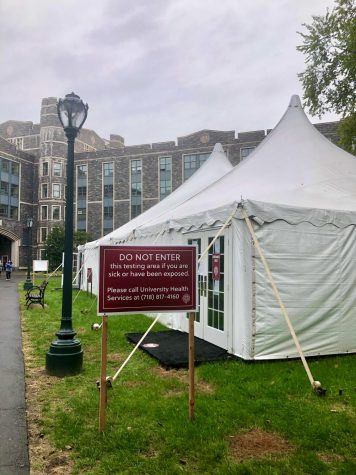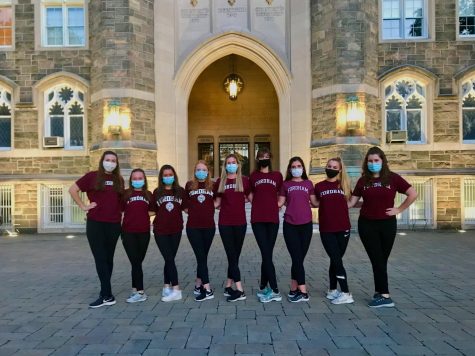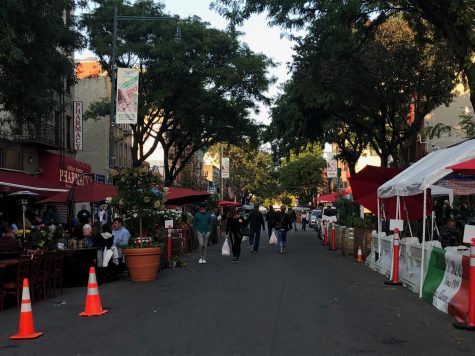Historic Mott Haven Neighborhood Turns 50
The exhibit, pictured above, is mainly made up of photographs detailing the architecture and layout of Mott Haven. (Gracie Davis/The Fordham Ram)
February 12, 2020
Mott Haven, a historic district in the South Bronx centered on Alexander Avenue, was the first location in the Bronx to be given landmark designation in 1969 by the NYC Landmarks Preservation Committee. Thus, 2019 marked its recent 50th anniversary. Bertine Block, the East Historic District of Mott Haven, would be separately landmarked in 1994.
According to the NYC Landmarks Preservation Society, a landmark must be “a building, property, or object that has been so designated because it has a special character or special historical or aesthetic interest or value as part of the development, heritage, or cultural characteristics of the city, state, or nation.”
A historic district is “a group of buildings, properties or sites by one of several entities on different levels that are recognized as historically or architecturally significant,” said the NYC Landmarks Preservation Society.
The Bronx County Historical Society celebrated the historic 50th anniversary with an exhibit detailing what the neighborhood has been and what it has come to be. The exhibit is primarily photograph-based and focuses on the unique layout of the neighborhood as well as the distinct architecture.
The library, police station, churches — Tercera Iglesia Bautista (Third Baptist Church) and St. Jerome’s Roman Catholic Church — and town houses are specifically significant in the culture of the district. The historic district contains some of the very first town houses erected in the Bronx, which were built in the 1860s, according to official Bronx Borough Historian Lloyd Ultan.
“This is the first evidence there is of the urbanization of the Bronx,” he said. During this time — the late 19th century — Mott Haven predominantly housed Irish doctors and physicians,” Ultan said. Alexander Avenue was called, in slang, the ‘Irish 5th Avenue. It was not until later in the 20th century that Mott Haven became mainly black and Hispanic, according to Ultan.
The exhibit follows advancing technologies as they were brought to the Bronx and how they were used to connect Mott Haven to the broadening city that surrounds it. It places an emphasis on the influence of mass transportation and the growth of the Bronx in the 20th century.
“Mott Haven was the first area of the Bronx to be urbanized, and it was one of the major reasons why the western half of the Bronx was next to New York City as early as 1874,” said Ultan. “You see, the Bronx was part of New York City before Brooklyn, Queens and Staten Island were.”
The exhibit clearly contrasts the Bronx from other boroughs. In the early 1900s, the Bronx acted as a sort of refuge from the crowded streets of Manhattan.
“It was an area where people in the smoky city, from all the industry, escaped … to the suburban villages that were established — and Mott Haven was one of them,” said Ultan.
The exhibit also largely focuses on a family who lived in Mott Haven at 284 Alexander Avenuefrom 1901 until the 1970s. Sandra Eaton, the granddaughter of Dr. Ernst Wilkens, who first purchased the home and started a family in Mott Haven, donated photographs and documents that chronicled their time in the district.
Their home was one of the earliest town houses ever constructed in the Bronx, and Wilkens bought it for $6,350 at the time. It was used as both the Wilkens’ house and Dr. Wilkens’ office until his death, when it was passed on to his daughter Margaret. Both Dr. Wilkens and Margaret ardently photographed their own home life as well as life in their Mott Haven community.
“We want to make sure people understand where we were in the past and where we’re going to next,” said Clarence Addo-Yobo, senior interpreter at the Bronx Historical Society.
“With every younger generation, from what I’ve seen, we always want some sort of progression,” he said. “We want advanced technology, automated systems — and in order to do that, we have to get rid of the old, and replace it with the new … but we need to still somehow understand where we came from. That’s why [the Bronx County Historical Society] is here,” he said.
Ultan reminded visitors that, while the exhibit covers an extensive history of Mott Haven, the actual landmark designation occurred only 50 years ago.
“It’s an interesting exhibit that most people, I think, would enjoy seeing, for the importance of Mott Haven and the difference between Mott Haven roughly 100 years ago and Mott Haven today,” Ultan said. Mirroring Clarence’s outlook toward the future of Mott Haven as it is connected to the past, Ultan concluded by saying time marches on.
To learn more about the Mott Haven exhibit at the Bronx Historical Society, visit http://bronxhistoricalsociety.org/exhibits.










If you want a picture to show with your comment, go get a gravatar.